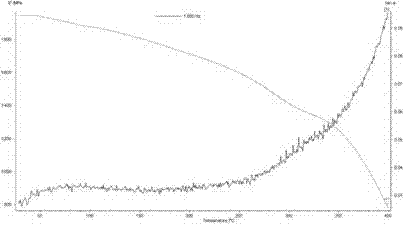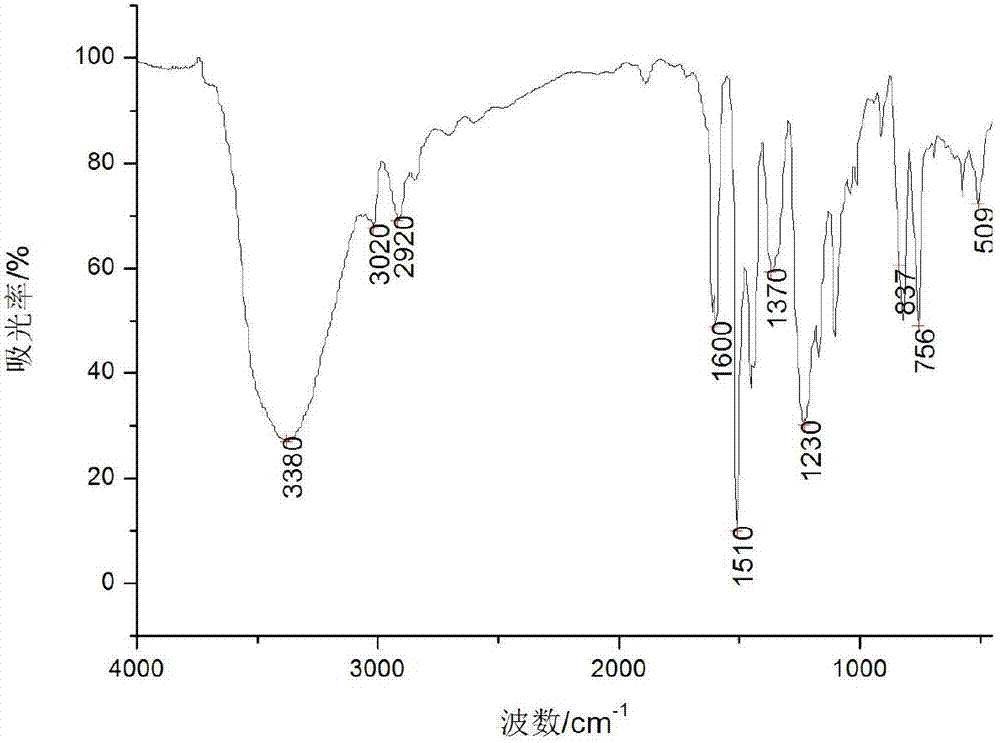Liquid phenolic-type cyanate resin suitable for RTM (resin transfer molding) process
A technology of phenolic cyanate and phenolic resin, which is applied in the field of liquid cyanate resin and can solve problems such as short gel time
- Summary
- Abstract
- Description
- Claims
- Application Information
AI Technical Summary
Problems solved by technology
Method used
Image
Examples
Embodiment 1
[0033] After melting 1636g of phenol, put it in a three-neck glass flask equipped with a thermometer, reflux condenser and stirring device, raise the temperature to 70°C and add 87g of dilute sulfuric acid (10%). 652g of formaldehyde (37% aqueous solution) was added in batches, and the temperature was raised to 90°C for 6 hours. Neutralize to neutral with 10% sodium hydroxide solution. After cooling to room temperature, the crude product of phenolic resin was obtained. The crude product was vacuum rotary evaporated from room temperature to 150°C until no phenol vapor was present, then cooled to room temperature to obtain a brown yellow phenolic resin.
[0034] The obtained phenolic resin had an average molecular weight of 310 and a melting point of 60°C.
Embodiment 2
[0036] Get 200g acetone and add in the three-neck glass flask of thermometer, reflux condenser and stirring device, cool to-10 ℃, get 50g cyanogen bromide and phenolic resin in 20g example 1 and dissolve in acetone. 40 g of triethylamine was gradually added dropwise, and after the dropwise addition was completed, the temperature was raised to 5°C for 2 hours of reaction. After standing for 1 h, the salt was removed by filtration, and the crude product was obtained after distilling off acetone. Extract the crude product with dichloromethane, wash the extract with 5% hydrochloric acid, and separate the organic phase; wash three times with deionized water, then dry with magnesium sulfate; filter and distill off the solvent to obtain a liquid cyanate resin.
[0037] Phenolic cyanate resin has an average molecular weight of 390, a viscosity of 600cP at 20°C, and a thermal curing temperature of 200-300°C.
Embodiment 3
[0039] Get 200g of acetone and add in the three-neck glass flask of thermometer, reflux condenser and stirring device, cool to-10 ℃, get 50g of cyanogen bromide and 30g of phenolic resin in example 1 and dissolve in acetone. 40 g of triethylamine was gradually added dropwise, and after the dropwise addition was completed, the temperature was raised to 5°C for 2 hours of reaction. After standing for 1 h, the salt was removed by filtration, and the crude product was obtained after evaporating acetone. Extract the crude product with dichloromethane, wash the extract with 5% hydrochloric acid, and separate the organic phase; wash three times with deionized water, then dry with magnesium sulfate; filter and distill off the solvent to obtain a liquid cyanate resin.
[0040] Phenolic cyanate resin has an average molecular weight of 380, a viscosity of 580cP at 20°C, and a thermal curing temperature of 200-300°C.
PUM
| Property | Measurement | Unit |
|---|---|---|
| Melting point | aaaaa | aaaaa |
| Viscosity | aaaaa | aaaaa |
| Viscosity | aaaaa | aaaaa |
Abstract
Description
Claims
Application Information
 Login to View More
Login to View More - Generate Ideas
- Intellectual Property
- Life Sciences
- Materials
- Tech Scout
- Unparalleled Data Quality
- Higher Quality Content
- 60% Fewer Hallucinations
Browse by: Latest US Patents, China's latest patents, Technical Efficacy Thesaurus, Application Domain, Technology Topic, Popular Technical Reports.
© 2025 PatSnap. All rights reserved.Legal|Privacy policy|Modern Slavery Act Transparency Statement|Sitemap|About US| Contact US: help@patsnap.com



